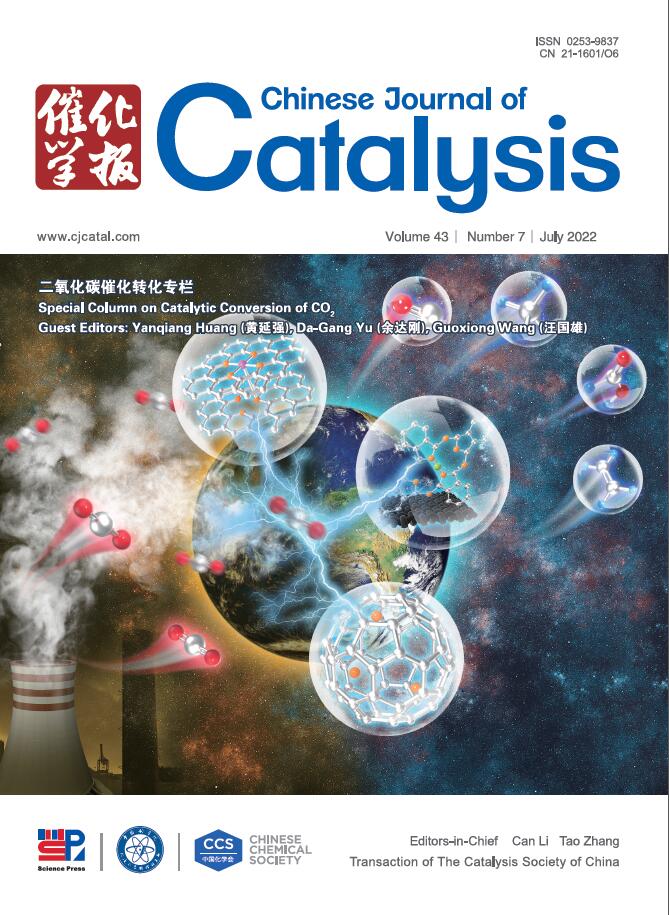Highly conjugated and chemically stable three-dimensional covalent organic frameworks for efficient photocatalytic CO2 reduction
IF 17.7
1区 化学
Q1 CHEMISTRY, APPLIED
引用次数: 0
Abstract
Covalent organic frameworks (COFs), as efficient photocatalysts, can convert CO2 and H2O into value-added fuel, thus improving the deteriorating ecological environment. However, achieving high photocatalytic efficiency and selectivity without relying on noble metals or sacrificial agents remains a significant challenge. Here, a highly conjugated three-dimensional (3D) COF 3D-COF-1 with imine linkage is constructed by the combination of two rigid and conjugated orthogonal building blocks (spirobifluorene and bicarbazole) with good photoactivites. Through a simple post-synthetic reduction, a chemically stable and amine-linked 3D-COF-2 which maintains excellent crystallinity and porosity can be obtained. Notably, the 3D-COF-2 exhibits excellent performance in CO2 reduction and exceptional selectivity of CO due to the highly conjugated structure and abundant amine groups as chemisorption sites for selectively capturing CO2. Under the irradiation of visible light and without noble metals and sacrificial agents, 3D-COF-2 produces 1070 μmol g-1 of carbon monoxide in 4.5 h, and the selectivity is close to 100%.
用于高效光催化CO2还原的高共轭和化学稳定的三维共价有机框架
共价有机框架(COFs)作为高效的光催化剂,可以将CO2和H2O转化为增值燃料,从而改善日益恶化的生态环境。然而,在不依赖贵金属或牺牲剂的情况下实现高光催化效率和选择性仍然是一个重大挑战。本文通过结合两种具有良好光活性的刚性和共轭正交构建块(螺比芴和双卡巴唑),构建了具有亚胺键的高共轭三维(3D) COF 3D-COF-1。通过简单的合成后还原,可以获得化学稳定的胺联3D-COF-2,并保持良好的结晶度和孔隙度。值得注意的是,3D-COF-2具有优异的CO2还原性能和CO的选择性,这是由于其高度共轭的结构和丰富的胺基作为选择性捕获CO2的化学吸附位点。在可见光照射下,不含贵金属和牺牲剂,3D-COF-2在4.5 h内产生1070 μmol g-1的一氧化碳,选择性接近100%。
本文章由计算机程序翻译,如有差异,请以英文原文为准。
求助全文
约1分钟内获得全文
求助全文
来源期刊

Chinese Journal of Catalysis
工程技术-工程:化工
CiteScore
25.80
自引率
10.30%
发文量
235
审稿时长
1.2 months
期刊介绍:
The journal covers a broad scope, encompassing new trends in catalysis for applications in energy production, environmental protection, and the preparation of materials, petroleum chemicals, and fine chemicals. It explores the scientific foundation for preparing and activating catalysts of commercial interest, emphasizing representative models.The focus includes spectroscopic methods for structural characterization, especially in situ techniques, as well as new theoretical methods with practical impact in catalysis and catalytic reactions.The journal delves into the relationship between homogeneous and heterogeneous catalysis and includes theoretical studies on the structure and reactivity of catalysts.Additionally, contributions on photocatalysis, biocatalysis, surface science, and catalysis-related chemical kinetics are welcomed.
 求助内容:
求助内容: 应助结果提醒方式:
应助结果提醒方式:


